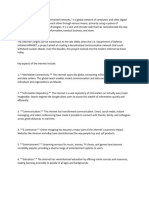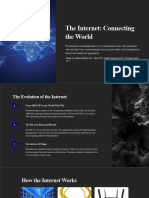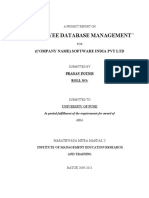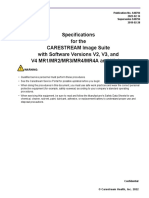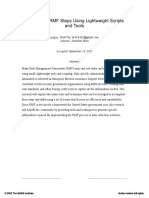1.
Introduction to the Internet
The internet is a global network that connects millions of private, public, academic, business, and
government networks across the world. It enables the exchange of information and services,
allowing users to communicate, share resources, and access vast amounts of data. Since its
inception in the late 20th century, the internet has transformed how we interact, learn, and
conduct business, becoming a fundamental aspect of modern life.
2. History and Development
The origins of the internet date back to the 1960s with ARPANET, a project funded by the U.S.
Department of Defense. Initially designed for military communication, it evolved into a network
that allowed multiple computers to communicate. The introduction of the Transmission Control
Protocol/Internet Protocol (TCP/IP) in the 1980s standardized the way data is transmitted over
networks, paving the way for the internet as we know it today.
3. Structure and Functionality
The internet is built on a decentralized structure, meaning no single entity controls it. It consists
of various components, including servers, routers, and data centers, all interconnected through
physical cables and wireless connections. Websites are hosted on servers, and users access them
through browsers using uniform resource locators (URLs). This technological framework allows
for the seamless transfer of data across different devices and platforms.
4. Impact on Communication
One of the most significant impacts of the internet is on communication. Email, instant
messaging, and social media platforms have revolutionized how people connect. Geographic
boundaries are less relevant, enabling real-time communication across the globe. This ease of
access has fostered relationships, collaboration, and the sharing of ideas, while also giving rise to
new forms of social interaction and community building.
5. Economic Transformation
The internet has dramatically transformed the global economy. E-commerce has surged,
allowing businesses to reach customers worldwide and consumers to shop from the comfort of
their homes. Digital marketing, online banking, and remote work have become prevalent,
creating new job opportunities and industries. Startups can scale rapidly due to lower overhead
costs and broader market access, fostering innovation and entrepreneurship.
6. Accessibility and Digital Divide
Despite its widespread influence, access to the internet is not uniform. The digital divide refers to
the gap between those who have easy access to the internet and those who do not, often
influenced by socioeconomic factors. This disparity can hinder opportunities for education,
�employment, and access to information, highlighting the need for policies that promote equitable
access to technology.
7. Security and Privacy Concerns
As internet usage grows, so do concerns about security and privacy. Cyberattacks, data breaches,
and identity theft pose significant threats to individuals and organizations. Additionally, the
collection and misuse of personal data by companies raise ethical questions. Users must navigate
these challenges by employing security measures such as strong passwords, encryption, and
privacy settings.
8. The Future of the Internet
Looking ahead, the internet continues to evolve with advancements in technology. Concepts like
the Internet of Things (IoT), artificial intelligence, and 5G connectivity promise to further
integrate the internet into daily life. As these technologies develop, they may enhance efficiency
and connectivity but also raise new ethical and regulatory challenges that society must address.
The future of the internet will likely be shaped by ongoing debates about access, security, and the
role of technology in our lives.










